“Great things are not done by impulse, but by a series of
small things brought together.”
- Vincent Van Gough
The Role of Press-On Prisms in Hemianopsia
The Fresnel Press-on lenses used in ophthalmic care today are wafer thin lenses. They are manufactured by the 3M company. 3M Press-on Optics are fabricated from flexible static vinyl which allows them to be easily cut to fit on ophthalmic eyewear lenses. They are available in both lenses and prisms, and available in prism powers up to 40 prism diopters.

In standard ophthalmic materials, higher power prism lenses can become very thick and often to the point that they are not practical to place in eyewear. Press-on prisms are made of rows of miniature prisms, that together create the prismatic effect while not increasing the thickness.
The Origin of Fresnel Lenses
The French physicist, Augusti-Jean Fresnel is credited with the invention of the 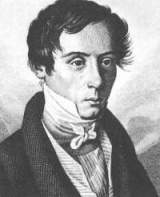 concept of this form of lens. Their initial use was primarily to replace the very thick lenses used in lighthouses. To obtain lenses powerful enough for lighthouses, massive heavy lenses were required. By designing the lens as a series of small segments, rather than one large lens, the great weight could be removed.
concept of this form of lens. Their initial use was primarily to replace the very thick lenses used in lighthouses. To obtain lenses powerful enough for lighthouses, massive heavy lenses were required. By designing the lens as a series of small segments, rather than one large lens, the great weight could be removed.
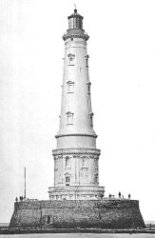 Cordouan LighthouseThe first Fresnel lens was placed in the Cordouan Lighthouse at the mouth of the Gironde estuary in 1823. Augusti-Jean Fresnel lived only to age 39, but did important work in diffraction optics and polarization.
Cordouan LighthouseThe first Fresnel lens was placed in the Cordouan Lighthouse at the mouth of the Gironde estuary in 1823. Augusti-Jean Fresnel lived only to age 39, but did important work in diffraction optics and polarization.
The thin flexible type of press-on lens used in eyecare, were developed by the 3M corporation. In the early years of visual field rehabilitation, they were often the only viable option to apply very high amounts of prism to treat hemianopic field loss. They are applied to the back of the lens.
The Pros and Cons of Fresnel Press-on Optics
The main advantage of 3M Press-ons Optics is that they are wafer thin compared to a normal ophthalmic prism. See the picture to the right. Note, the very thick prism,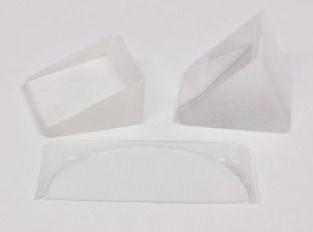 which are 25 and 45 prism diopters. Then note the wafer thin Fresnel 40 prism diopter lens below them. The second major advantage is the ability to custom cut these to fit many different purposes. Also, they have the advantage of being applied or removed at anytime.
which are 25 and 45 prism diopters. Then note the wafer thin Fresnel 40 prism diopter lens below them. The second major advantage is the ability to custom cut these to fit many different purposes. Also, they have the advantage of being applied or removed at anytime.
The disadvantage is that the flexible static vinyl material that gives these lenses the ability to be easily cut to custom shapes, unfortunately, reduces the contrast of objects viewed through the lens.
Notice below the two images of a contrast sensitivity chart photographed with and without a 40 diopter Fresnel press-on. Notice the loss of contrast through the 40 prism diopter press-on Fresnel prism.
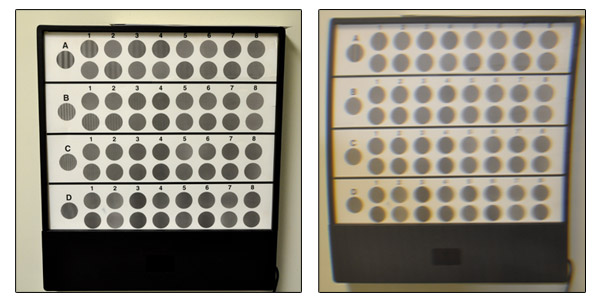
Fresnel Lenses as Visual Field Expanders
We can duplicate most of the visual field expanders with Fresnel press-on prisms. They are inexpensive and easily modified. This makes them very helpful in demonstrating the concept of a Gottlieb VFAS, EP Horizontal or Chadwick by applying them to the patient’s own eyewear for trial wear. They are also beneficial as an 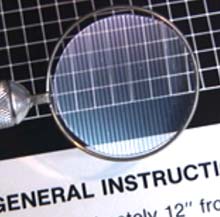 option when cost is the major concern and the patient’s goals are modest.
option when cost is the major concern and the patient’s goals are modest.
Compared to a Gottlieb VFS or Chadwick Hemianopsia Lens, the view through the Fresnel Press-on Prism is slightly hazy. Notice the picture to the right. The Fresnel lens shows a slight haziness that can reduce contrast for the patient. The weaker contrast through the soft plastic Fresnel Press-ons compared to the newer visual field expanders can be a negative for some patients particularly if the patient has reduced contrast sensitivity. We do not recommend these for high functioning hemianopsia patients, especially if driving is a consideration owing to the need for higher contrast.
The Gottlieb VFAS and Fresnel Version
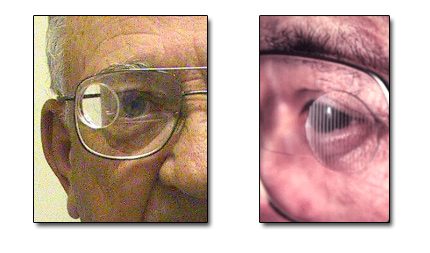
Above, we see an example of a Gottlieb Visual Field Awareness System on the left, and on the right an example of a “Gottlieb style” lens in a Fresnel Press-on lens.
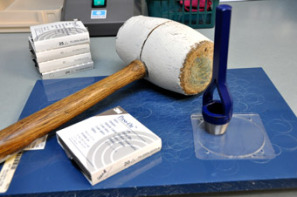 We cut 20 prism diopter Fresnel press-on lenses with hollow punches. These are cut in advance, so we can quickly apply one to the patient’s eyewear, and have them test the lens in real world activities.
We cut 20 prism diopter Fresnel press-on lenses with hollow punches. These are cut in advance, so we can quickly apply one to the patient’s eyewear, and have them test the lens in real world activities.
Here, we see the hollow punches use to cut the lenses in a perfect circle, thus avoiding rough edges that cause reflective glare and avoids asymmetry that makes the lenses more visible. After cutting the lens any rough edges are smoothed with a fine file.
The Chadwick Hemianopsia and Fresnel Version
The Chadwick hemianopsia lens works similar to the Gottlieb VFAS, and can be reproduced with Fresnel Press-on lenses. The Chadwick Hemianopsia lens requires a very small frame to keep the thickness within an acceptable range. The Fresnel lens is not limited by the size of the frame.
Below is a Chadwick Hemianopsia lens on the left and a press-on version of the Chadwick on the right.
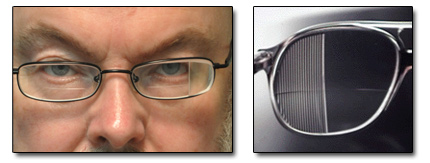
The EP Horizontal Lens and Fresnel Version
The EP Horizontal is actually a form of a Fresnel lens made, however, with a hard plastic that reduces contrast only slightly compared to the soft plastic of the 3 M Press-on Optics. Because it is a constant view system, the slight contrast difference may actually help patients differentiate the main image from the EP Horizontal images. We can create Fresnel Press-on versions of the EP Horizontal with 40 prism diopters Fresnel with either one or two segments, one above and one below eye level.
Below is a press-on version of the EP lens on the left and a EP Horizontal Lens in the picture on the right side
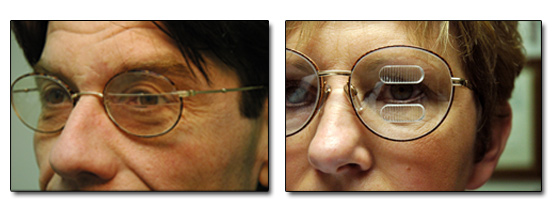
Please contact us if you have any questions.
The Low Vision Centers of Indiana
Richard L. Windsor, O.D., F.A.A.O., D.P.N.A.P.
Craig A. Ford, O.D., F.A.A.O.
Laura K. Windsor, O.D., F.A.A.O.
Ali E. Prible, O.D.
Indianapolis (317) 844-0919
Fort Wayne (260) 432-0575
Hartford City (765) 348-2020
